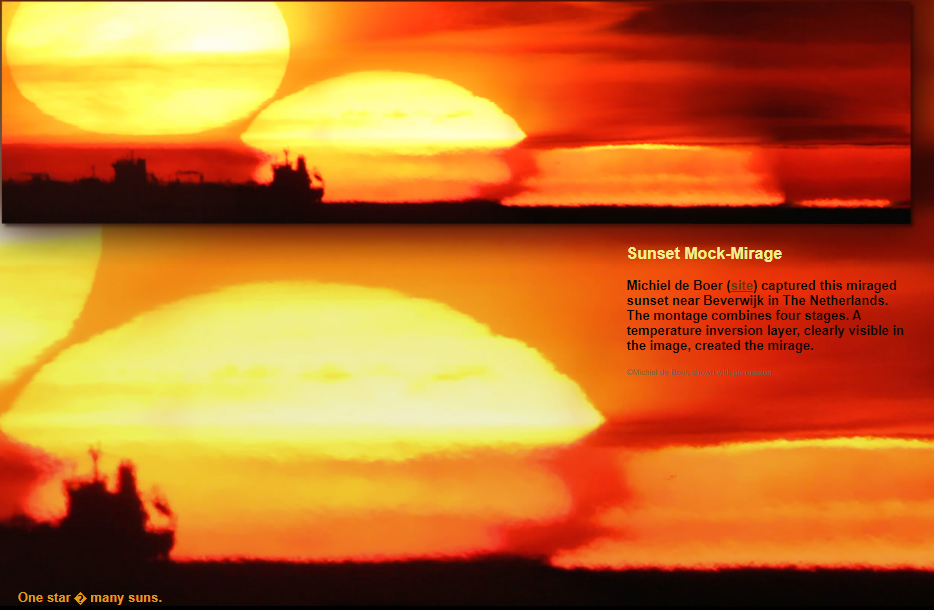OPOD - Mock Mirage Sunset
OPOD - Exploring the Phenomenon of Mock Mirage Sunsets
Have you ever witnessed a sunset that seemed to defy reality? A mirage sunset, like the one captured by Michiel de Boer near Beverwijk in The Netherlands, can leave you in awe of the wonders of atmospheric optics. In this article, we will delve into the captivating world of mock mirage sunsets, uncovering the science behind these enchanting visual phenomena.
The Magic of Mirage Sunsets
When observing a mirage sunset, you may be greeted by an extraordinary sight—a bright oval sun descending into a dark atmospheric band. Inside this band, solar pancakes constantly change their shape, creating a mesmerizing spectacle. As the sun sinks further, the topmost sun disappears, leaving only the pancakes. Simultaneously, the darker band itself starts to empty as the pancakes thin and migrate to its top and bottom.
Unveiling the Three Suns
The classical mock mirage sunset typically presents three suns. The first sun, situated above the dark layer, appears to slide downwards. As it does so, the layer seemingly obscures the sun's lower edge, giving the illusion of a false horizon sunset. This image may appear to be the "real" one, but the second and third suns are equally real and contribute to the captivating display.
The second sun resides wholly within the layer and is visible only as a slice. If there happens to be a fortuitously placed sunspot, it may reveal itself as inverted. This second sun rises as the sunset progresses. On the other hand, the third image is also within the layer but remains upright and gradually sinks.
Unraveling the Mirage Formation
The mirage phenomenon arises during temperature inversions, which occur when cooler air lies beneath warmer air. As the nearly horizontal rays of the setting sun pass through these temperature and density gradients, they refract and curve, appearing to originate from new directions. This bending of light gives rise to the illusion of multiple suns and creates the captivating mirage sunset.
Michiel de Boer's Mirage Masterpiece
Michiel de Boer's photograph of the mirage sunset near Beverwijk showcases a particularly rich display. Unlike the typical mock mirage sunset, this image exhibits at least three distinct images within the main inversion layer. Additionally, two images can be observed above the layer, and the topmost sun appears significantly flattened. The complexity of the temperature profile, characterized by multiple inversion kinks, contributes to the intricacy of this stunning mirage.
The Green Flash Phenomenon
Mock mirages also have the potential to generate small, short-lived green flashes on the uppermost solar limb. These captivating green flashes are frequently photographed but should not be observed directly with the naked eye, as they can be hazardous. Instead, these ephemeral bursts of green light should be admired through the lens of a camera.
Unlocking Nature's Illusions
Mock mirage sunsets offer a captivating glimpse into the remarkable world of atmospheric optics. These illusions, shaped by temperature inversions and the bending of light, provide a feast for the eyes and ignite our curiosity about the mysteries of nature. So, the next time you witness a sunset that seems too magical to be real, remember that nature's illusions are often more enchanting than we could ever imagine.

Sunset Mock-Mirage
Michiel de Boer (site) captured this miraged sunset near Beverwijk in The Netherlands. The montage combines four stages. A temperature inversion layer, clearly visible in the image, created the mirage.
©Michiel de Boer, shown with permission

One star � many suns.
A bright oval sun sinks into a dark atmospheric band. Inside the band are solar pancakes ever changing their shape. Eventually the topmost sun disappears altogether leaving only the pancakes. Then the darker band itself empties as the pancakes thin and migrate to its top and bottom.
The classical 'mock-mirage' has three suns. The first, above the dark layer, slides downwards. The layer appears to obscure the sun's lower edge giving the appearance of a sunset at a false horizon. This image seems to be the �real� one but the second and third suns are no less real.
The second sun is wholly within the layer and thus is only seen as a slice. A fortuitously placed sunspot would reveal it as inverted. It rises as sunset progresses.
The third image , also within the layer, is upright and sinks.
The mirage forms during temperature inversions � unusually cooler air beneath warmer. The almost horizontal setting sun rays refract at the temperature/density gradients and curve to appear to come from new directions.
Michiel de Boer�s mirage is richer than the above. There are at least three rather than two images in the main inversion layer. Two images are above the layer and the topmost sun is strongly flattened. The temperature profile was complex with several inversion kinks.
Mock-mirages generate small short-lived green flashes on the uppermost solar limb. They are frequently photographed but do not hazard eyes by searching visually.
Note: this article has been automatically converted from the old site and may not appear as intended. You can find the original article here.
Reference Atmospheric Optics
If you use any of the definitions, information, or data presented on Atmospheric Optics, please copy the link or reference below to properly credit us as the reference source. Thank you!
-
<a href="https://atoptics.co.uk/blog/opod-mock-mirage-sunset/">OPOD - Mock Mirage Sunset</a>
-
"OPOD - Mock Mirage Sunset". Atmospheric Optics. Accessed on December 26, 2024. https://atoptics.co.uk/blog/opod-mock-mirage-sunset/.
-
"OPOD - Mock Mirage Sunset". Atmospheric Optics, https://atoptics.co.uk/blog/opod-mock-mirage-sunset/. Accessed 26 December, 2024
-
OPOD - Mock Mirage Sunset. Atmospheric Optics. Retrieved from https://atoptics.co.uk/blog/opod-mock-mirage-sunset/.